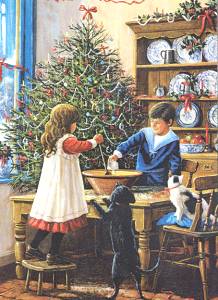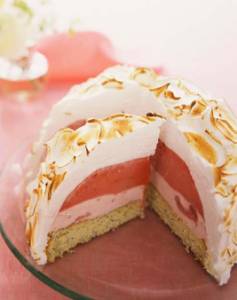December 10, 2006 Welcome Home Bakers and Friends,I think it's safe to say that we all made it through Halloween, Ramadan and Thanksgiving, and hopefully all of your baking and cooking endeavors turned out nicely. Now, it's that time for preparing ourselves for Hanukkah, Christmas, Kwanzaa and New Year's. I hope to help you out and offer you some tasty recipes for these special holidays. But first, let me say that my husband Kenny and I enjoyed a happy Halloween at home, spending it with my cousin and her husband. We had a simple dinner, sort of "deli" style; cold cuts, smoked salmon and bagels, potato salad, egg salad and sliced tomatoes, and for dessert a decadent chocolate cake. I also found in my local market's bakery and candy department some really delicious Halloween pumpkin chocolate truffles by the famous San Francisco "chocolatier" Joseph Schmidt. Each pumpkin is made with orange colored white chocolate surrounding a dark chocolate inner shell and green stem, with spice flavored truffle filling. Oh, I can't tell you how gorgeous and yummy these were. If you're so inclined, as I am, to love chocolate, and chocolate truffles in particular, visit Joseph Schmidt's Confections online store at: http://www.josephschmidtconfections.com to order the best truffles (and many other chocolate goodies) in the world. Even if you don't (or can't) order his wonderful chocolates right now, just look at his confections on his website, truly amazing! 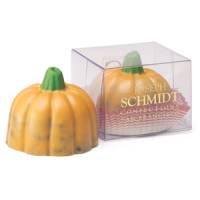 Joseph Schmidt Confections Pumpkin Truffle For Thanksgiving, we decided to spoil ourselves and splurged on a scrumptious feast at our favorite local restaurant, Bistro V. This intimate and lovely "country" style restaurant prepares French and Italian cuisine with Peruvian and Mediterranean influences. It's on the outskirts of the town of Sebastopol, in Sonoma's wine country area of northern California. It's our favorite place to go when we want superb food but in a simple, quiet, and warm and friendly atmosphere. The Chef (and owner) Rick Vargas and his wife, Pastry Chef Meekk, are so nice and make you feel at home in their restaurant, which is what we needed on Thanksgiving, as neither my husband or myself were able to be with family this year. Click here to view Bistro V's website Now that you've heard about what we did for these fun and special days, it's time to get to the recipes for the upcoming holidays. Enjoy! 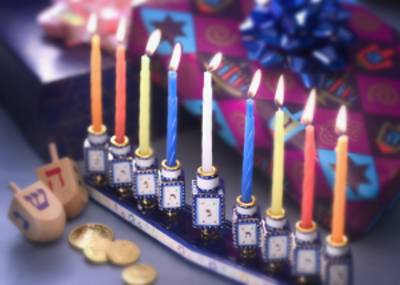
HanukkahDecember 15th through December 22nd 2006(Jewish holidays always begin at sundown) Every year between the end of November and the end of December, Jewish people around the world celebrate the holiday of Hanukkah (also spelled Chanukah), the Festival of Lights. Hanukkah begins on the 25th day of the Hebrew month of Kislev, but the starting date on the western calendar varies from year to year. The holiday celebrates the events which took place over 2,300 years ago in the land of Judea, which is now Israel Hanukkah, the Festival of Lights, is a celebration of the victory of the Maccabees and the rededication of the Jerusalem Temple. It also commemorates the miracle of the oil that burned for 8 days. As with all Jewish holidays, special foods are prepared. An example of some of the desserts served at Hanukkah are Cheese Blintzes, Rugelach, Hanukkah Cookies such as Dreidel Cookes, Peppermint Crisps, Chanukah Poppy Seed Cookies, Halvah, Mandel Brot (a kind of Jewish biscotti), and always Sufganiyot, the jelly filled doughnuts. 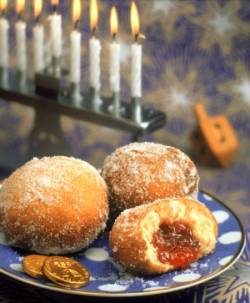
Miniature Jam-Filled SufganiyotSufganiyot are widely consumed in Israel in the weeks leading up to and including the Hanukkah holiday. At Hanukkah, Jews observe the custom of eating fried foods in commemoration of the miracle associated with the Temple oil.Servings: Makes 42 mini sufganiyot Comments: During Hanukkah in some Israeli communities, vendors sell sufganiyot by the basketful. Try making these mini sufganiyot for Hanukkah this year. Your family will love them. Ingredients: 3 1/4 to 3 1/2 cups all-purpose flour 2 packages active dry yeast 1/2 teaspoon ground cinnamon 1 cup water 1/3 cup granulated sugar 2 tablespoons cooking oil 1/2 teaspoon salt 1 egg 1/2 teaspoon vanilla extract 1/4 cup strawberry jam (or any other type of jam or preserves) Cooking oil for deep frying Sifted confectioners' sugar Instructions: 1. In a large mixing bowl stir together 1 1/4 cups of the flour, the yeast, and cinnamon; set aside. 2. In a medium saucepan heat and stir water, sugar, cooking oil, and salt just until warm (120 to 130 degrees F/48 to 54 degrees C). Add oil mixture to flour mixture; add egg and vanilla. Beat with an electric mixer on low to medium speed for 30 seconds, scraping the sides of the bowl constantly. Beat on high speed for 3 minutes. Using a wooden spoon, stir in as much of the remaining flour as you can. 3. Turn dough out onto a lightly floured surface. Knead in enough of the remaining flour to make a moderately soft dough that is smooth and elastic (3 to 5 minutes total). Shape dough into a ball. Place in a lightly greased bowl, turning once to grease the surface of the dough. Cover and let rise in a warm place until double in size (about 1 hour). 4. Punch dough down. Turn dough out onto a lightly floured surface. Divide in half. Cover and let rise for 10 minutes. 5. Roll dough, 1 portion at a time, to 1/4-inch thickness. Cut dough with a floured 1 1/2-inch biscuit cutter, dipping cutter into flour between cuts. Place about 1/4 teaspoon jam onto the centers of half of the circles. Lightly moisten edges of circles; top with remaining circles. Press edges together to seal. Repeat with remaining dough and fillings. Reroll and cut trimmings. 6. Fry filled doughnuts, 3 or 4 at a time, in deep hot oil (365 degrees F/185 degrees C) about 1 minute on each side or until golden, turning once with a slotted spoon. Remove from oil; drain on paper towels. Sprinkle with powdered sugar. Cool on wire racks. Makes about 42 mini-sufganiyot. Source: DianasDesserts.com Click here to view recipe and photo of Sufganiyot on Diana's Desserts Website 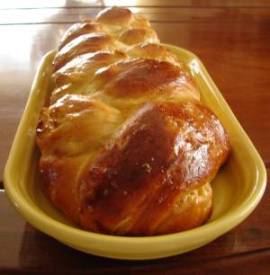
Braided Apple Challah for HanukkahServings: Makes 1 large loaf or 2 small loavesComments: Use Bread Machine for Making Dough - Bake Bread in Traditional Oven Braiding your challah for Hanukkah is traditional but adding apples to the dough is something a little bit different. Usually the challah is topped with poppy or sesame seeds but this recipe omits adding the seeds for the topping and instead this challah is full of little pieces of diced apples inside. Your guests will enjoy the little bits of apple in the challah as it's something a bit unusual for Hanukkah, but more typical for Rosh Hashanah. If you want to make this apple challah for Rosh Hashanah, make round loaves instead. Enjoy! Ingredients: 3/4 cup warm water (110 degrees F/43 degrees C) 1 large egg 3 tablespoons butter or margarine, cut into small pieces, or 2 tablespoons vegetable oil 1 1/4 teaspoons salt 3 cups bread flour (unbleached all-purpose flour may be substituted for the bread flour, if needed) 1 tablespoon granulated sugar 2 tablespoons clear honey 2 teaspoons bread machine yeast or instant yeast 1/2 cup diced dried apples* (see notes below) or 1/2 cup fresh diced apples Egg Wash: 2 large egg yolks 2 tablespoons water Instructions: Notes: You will need 1 large or 2 medium size baking sheets if making 2 smaller loaves (or one very large baking sheet will work also). Dried diced apples may be purchased online at The Prepared Pantry in a 6.5 ounce (2 1/2 cups) package. Their web address is: http://www.preparedpantry.com. 1. Lightly grease or line with parchment paper one or two baking sheets. 2. Add warm water, egg, butter (or margarine or vegetable oil, if using), salt, flour, sugar, honey, and yeast to bread machine pan in the order recommended by manufacturer. Select the Dough Cycle of your machine. Start the cycle. 3. When dough cycle is complete, remove dough from machine to a lightly floured work surface. Punch dough down and let rest for 5 minutes. If necessary, knead in enough flour to make dough easy to handle. Knead in diced apples. 4. Making 1 loaf: If making one (1 1/2-pound) loaf, divide dough into 3 equal size pieces and roll each piece into 20-inch long rope. Place ropes on prepared baking sheet. Braid by bringing left rope under center rope; lay it down. Bring right rope under new center rope; lay it down. Repeat braiding to the end of loaf. Pinch ends to seal and tuck under dough. Making 2 smaller loaves: If making two (3/4 pound) smaller loaves, divide dough in half. For each loaf, divide dough into 3 equal size pieces and roll each piece into a 12-inch long rope (you will have 6 ropes if making 2 smaller loaves). Place ropes on prepared baking sheets. Braid by bringing left rope under center rope; lay it down. Bring right rope under new center rope; lay it down. Repeat braiding to the end of loaf. Pinch ends to seal and tuck under dough. Repeat braiding with remaining 3 ropes for second loaf. 5. Egg Wash: Lightly beat egg yolks with water. Brush loaf (s) with half of the egg wash, saving the remaining egg wash to brush loaf (s) again before baking. Cover with plastic wrap and place a smooth cotton kitchen towel over plastic wrap and let loaf (s) rise in a warm, draft-free place until almost doubled in size, 45 to 50 minutes. 6. Preheat oven to 375 degrees F/190 degrees C. 7. Baking: Brush loaf (s) with the remaining egg wash, REDUCE oven temperature to 350 degrees F/180 degrees C and bake for 30 to 35 minutes or until done (bread is done if it registers 190 degrees F/87 degrees C with instant-read thermometer). Remove bread from baking sheet and cool completely on wire rack (about 2 hours). Tip: Cover bread with aluminum foil after 10 to 15 minutes of baking to prevent excess browning (for even browning when baking two loaves, switch positions of sheets halfway through baking). Storage: Bread may be frozen once cooled completely (2 hours). Wrap in aluminum foil, then place bread in a ziploc bag. Label and date. Bread can be frozen for up to 3 months. Thaw for 1 hour at room temperature before serving. Makes 1 (1 1/2-pound) loaf or 2 small (3/4 pound) loaves. Photograph taken by Diana Baker Woodall © 2006 Source: DianasDesserts.com Click here to view recipe and photo of Braided Apple Challah for Hanukkah on Diana's Desserts Website 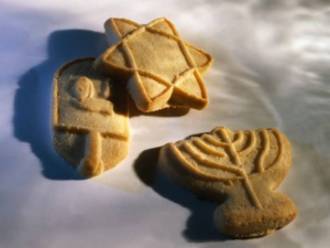
Hanukkah Sugar CookiesMakes 3 to 4 dozen cookies, depending on size of cookie cuttersComments: Here's a fun and easy recipe for Hanukkah Sugar Cookies that can be made with the help of your children. They'll love making the icing and decorating the cookies. A great way to get your kids involved in the holiday and also learn a little about baking cookies. Ingredients: 1 (8 ounce) package cream cheese, softened 1 cup (2 sticks/8 oz./226g) butter or margarine, softened 1/3 cup granulated sugar 1/4 tsp. vanilla extract or 1/2 tsp. almond extract 2 cups all-purpose flour Colored or plain sugar (optional) Icing (see below) optional Instructions: Beat cream cheese, butter, granulated sugar and vanilla in large bowl with electric mixer on medium speed until well blended. Add flour; mix well. Cover. Refrigerate several hours or overnight. Preheat oven to 350 degrees F/180 degrees C. Roll dough on lightly floured surface to 1/8-inch-thickness. Cut into shapes with 2 to 3-inch dreidel, menorah and star of david cookie cutters; sprinkle with plain or colored sugar if desired or leave plain to frost later with icing (after cookies are baked and cooled). Icing cookies is optional. Place on ungreased baking sheets. Bake 12 to 15 minutes or until edges are lightly browned. Remove to wire racks. Cool completely and decorate with icing, if desired. Store cookies in an airtight container. Makes 3 to 4 dozen cookies, depending on size of cookie cutters. Icing (optional) Ingredients: 1 tablespoon orange juice plus additional juice, if needed 1 cup sifted confectioners' sugar 1/4 teaspoon vanilla extract Food coloring (optional) Instructions: In a medium mixing bowl combine confectioners' sugar, orange juice, and vanilla. Stir in additional juice, 1 teaspoon at a time, until the icing reaches piping consistency. If desired, tint a portion of the icing with food coloring. Decorate cookies as desired with icing. Click here to view recipe and photo of Hanukkah Sugar Cookies on Diana's Desserts Website 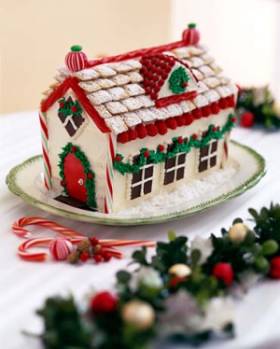
ChristmasMonday December 25, 2006Of course, we all know that Christmas celebrates the birth of Jesus Christ, but now-a-days, it's a festive holiday that is shared by so many people around the world. It's a time for giving, and a time for reflection, and a time to enjoy the wonderful mystical time that only Christmas seems to encompass. During this special time of the year, all over the world, people seem to really enjoy baking and cooking their much loved savory dishes and sweet desserts. Many of these dishes become family treasures and the recipes are often handed down through generations. So often, children and grandchildren will continue with the tradition of making these special holiday foods. Here are some of my favorite goodies for Christmas. I hope some of them will become your treasured family favorites also. 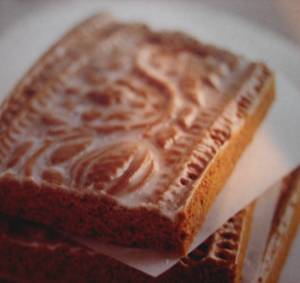
Soft Glazed GingerbreadServings: 12 to 20 cookies, depending on size of cutters that are usedComments: Several years ago during the holidays, I experimented with different thicknesses of gingerbread dough and patterned rolling pins and cookie molds. I found that the dough I was using made a perfect soft cookie with some adjustments to the butter and sugar, and the addition of a little extra molasses and corn syrup. The dough also kept the impression from an antique pin I had, and when it was glazed and cut into rectangles, the resulting cookies looked like tiles, with the glaze settling into the grooves and turning white from the crystallization of the sugar. Originally, I used what is called a thread glaze, meaning that sugar and water are cooked together to the thread stage, cooled slightly, and then brushed on. The brushing action made the sugar crystallize and set. A simple water icing, confectioners' sugar and water mixed together to a thin brushing consistency, is easier and works just as well. The glaze seals in the moisture in the cookie and gives it a perfect amount of extra sweetness. Kitchen Notes: Sift the confectioners' sugar before combining it with the water to ensure a smooth glaze. If you are using a pin or cookie forms with a carved design, make sure to flour the top of the dough so that it doesn't stick in the crevices of the design. As long as the flour is lightly and evenly distributed, it will disappear from the surface during baking. The patterned pin and cookie plaques are often sold as spingerle molds or pins, after the Scandinavian cookie traditionally made with them. Ingredients: Dough: 3 3/4 cups all-purpose flour 1 tablespoon unsweetened cocoa powder 4 teaspoons ground ginger 1 1/2 teaspoons ground cloves 2 teaspoons ground cinnamon 1/2 teaspoon baking soda 1 teaspoon salt 1 1/4 teaspoons black pepper, freshly ground 1 cup (2 sticks/8 oz./226g) unsalted butter, at room temperature 3/4 cup + 2 tablespoons granulated sugar 1 large egg 1/2 cup blackstrap or other dark molasses 2 tablespoons light corn syrup Glaze: 1 cup confectioners' sugar 2 tablespoon water Instructions: To Make the Dough: Stir together the flour, cocoa powder, ginger, cloves, cinnamon, baking soda, salt, and pepper in a mixing bowl. Set aside. Using a stand mixer fitter with the paddle attachment, beat the butter on medium-high speed until creamy. Slowly add the granulated sugar and mix on medium speed until the mixture is completely smooth and soft. Stop the mixer and scrape down the sides of the bowl with a rubber spatula as needed. Add the egg and mix well. Add the molasses and corn syrup and beat until incorporated. Stop the mixer again and scrape down the sides of the bowl. Add the flour mixture and beat on low speed until a dough forms that pulls away from the sides of the bowl and all the ingredients are well incorporated. Remove the dough from the bowl, flatten it on a large piece of plastic wrap into a rectangle about 1 inch thick, cover the dough with plastic wrap and refrigerate overnight. Preheat oven to 350 degrees F/180 degrees C. Line a baking sheet with parchment paper or nonstick liner. Unwrap the dough and place on a floured work surface. If using a plaque with a design, roll out the dough 1/3 inch thick, lightly dust the top with flour, press your cookie molds over the dough, and then cut out the shapes with a small knife and place on the prepared baking sheet, spacing them about 1 inch apart. Alternatively, using the mold as a guide, cut around it with a small knife, flip the mold over so the design is facing you and place the dough over it, pressing it into the design. Unmold the shapes onto the prepared baking sheet, leaving about 1 inch between them. If using a patterned rolling pin, lightly dust the lined baking sheet with flour and transfer the dough to the pan. Lightly dust the top of the dough with flour and roll it into a rectangle about 1/3 inch thick with a plain pin. Then, using the patterned pin, roll over the dough with enough pressure to ensure a clear impression of the design. Trim the sides with a small knife. It is not necessary to cut into smaller sizes before baking. Bake the cookies until lightly golden along the sides but still soft to the touch in the centers, 7 to 15 minutes. The timing will depend on the size of the individual cookies, or if you have made a single large patterned piece that will be cut after baking. While the cookies are baking, prepare the glaze. To Make the Glaze: In a small bowl, whisk together the confectioners' sugar and water until smooth. When the cookies are ready, remove from the oven and let cool on the pan on a wire rack for about 10 minutes. Then, while the cookies are still warm, using even strokes, brush a light coat of glaze on the top of each cookie, evenly covering it. Let the cookies cool completely. When the glaze dries, it should leave a shiny, opaque finish. If you have used a patterned pin to make a single large plaque, cut into the desired sizes with a small, very sharp knife. At the bakery, we cut them into 3-by-4-inch rectangles, but 1 1/2 by 4 inches makes a nice smaller size. The cookies will keep in an airtight container in a cool place for about 2 weeks. They do not freeze well, however, as the glaze becomes watery when they are thawed. Makes 12 to 20 cookies, depending on size of cutters. Icing Variation: If you want to make the traditional thread glaze for finishing cookies, heat 1 1/2 cups sugar and 1 cup water over low heat, stirring until the sugar dissolves. Then increase the heat to medium and cook without stirring until the mixture registers 225 degrees F/107 degrees C to 230 degrees F/110 degrees C on a candy thermometer. Remove from the heat and let the syrup cool to 180 degrees F/82 degrees C. Brush the syrup over the cooled cookies with a clean, dry natural-bristle pastry brush, brushing quickly back and forth to encourage sugar crystals to form. Once the crystallization begins, the glaze will continue to turn opaque over the next hour or so. Store as directed above. Source: Tartine, by Elisabeth M. Prueitt and Chad Robertson (Chronicle Books 2006). Click here to view recipe and photo of Soft Glazed Gingerbread on Diana's Desserts Website 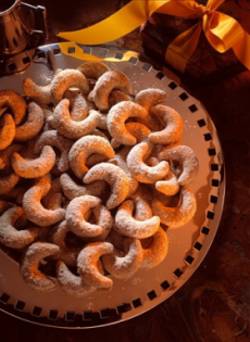
Viennese CrescentsServings: Makes 24 cookiesComments: A Great Christmas Cookie! Nutmeg perfumes these delicate cookies, making them particularly appealing. Because they are fragile, avoid crumbling by using a small metal spatula to remove them from the baking sheet. Ingredients: 1 cup all-purpose flour 3/4 cup walnuts 8 tbsp. (1 stick/4 oz./113g) chilled unsalted butter, cut into pieces 1/4 cup granulated sugar 1 tsp. vanilla extract 1/2 tsp. ground nutmeg Pinch of salt Confectioners' sugar Instructions: Preheat an oven to 325 degrees F/160 degrees C. In a food processor, combine the flour, walnuts, butter, granulated sugar, vanilla, nutmeg and salt. Pulse until the mixture resembles coarse meal. Then process continuously until the dough begins to gather together. Pinch off 2 tsp. of the dough and roll it between your palms to form a rope 2 1/2 inches long, slightly tapering it at both ends. On a large ungreased baking sheet, arrange the rope in a crescent shape. Repeat with the remaining dough, spacing the crescents about 1 inch apart. Bake until just firm to the touch, about 20 minutes. Transfer the baking sheet to a rack and let the cookies cool on the sheet for 5 minutes. Transfer the cookies to the rack to cool completely. Using a sieve, sift a light dusting of confectioners' sugar over the cooled cookies. Store in an airtight container at room temperature for up to 5 days. Makes about 24 cookies. Click here to view recipe and photo of Viennese Crescents on Diana's Desserts Website 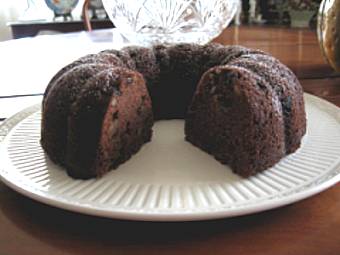
Victorian Christmas CakeServings: 10-12Comments: Make this old-fashioned cocoa flavored spiced applesauce cake for your Christmas dessert and your family and friends will be delighted. The smell of this cake baking in the oven is "to die for" and tastes even better once you've taken your first bite. Ingredients: 2 cups all-purpose flour 1 1/2 cups granulated sugar 1 1/2 teaspoons baking soda 2 tablespoons unsweetened cocoa 1 teaspoon ground cinnamon 1/2 teaspoon ground allspice 1/2 teaspoon ground cloves 1/2 teaspoon ground nutmeg 1 1/2 cups applesauce (unsweetened) 1 1/2 cups shortening (such as Crisco) 1/2 cup cider (sweet or hard cider) 3/4 cup chopped dates (optional) 3/4 cup raisins 1/2 cup chopped walnuts 2 eggs Garnish: (optional) Confectioners' sugar Whipped cream or Clotted cream Instructions: Preheat oven to 350 degrees F/180 degrees C. Grease and lightly flour a 10-inch tube or bundt pan. Sift dry ingredients into mixing bowl. Drop in shortening. Add applesauce and cider and mix with electric mixer. Add eggs and mix again. Stir in fruit and chopped nuts. Batter will be stiff. Pour into prepared tube or bundt pan. Bake in preheated 350 degree F/180 degree C oven for 1 hour. Remove to wire rack, let cool for 15 minutes, and invert onto rack to cool completely. Before serving, dust with confectioners' sugar if desired, and serve with whipped cream or clotted cream. Makes 10-12 servings. Photograph taken by Diana Baker Woodall © 2005 Click here to view recipe and photo of Victorian Christmas Cake on Diana's Desserts Website 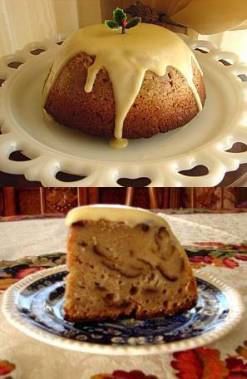
Kenny's Christmas Figgy PuddingServings: 8Comments: What is a Figgy Pudding? Here's the answer from Marion Owen, the Upbeet Gardener, with a little added information from Diana's Desserts: Figgy pudding is a traditional steamed British pudding. Figs, dried ones (in the recipe below, fresh figs are used) go into figgy pudding. So do nuts, dates, bread crumbs, spices and more. You mix it all up and put it in a pudding mold. You put the pudding mold in a large pan (like a roasting pan or casserole) and fill the pan with hot water to cover the bottom 1/3 of the mold. This "water bath" will help the pudding cook evenly and keep it from scorching. Baking the pudding takes about 2 to 2 1/2 hours. Then presto, change-o: Figgy pudding! Though it's actually more like a cake. First created in the 1400's, figgy pudding became popular as a Christmas tradition in Victorian England in the mid 1800's; the setting of Charles Dickens' A Christmas Carol. Why would you want to eat one today? Well, traditions, edible and otherwise, tend to make people feel good. It’s that comfort food thing. And the figs in figgy pudding hold lots of good fiber and nutrients like iron, calcium, and potassium. I'm told if you like Fig Newtons, Christmas flavors and smells, you'll like figgy pudding. From Marion Owen, The Upbeet Gardener at: http://garden.blogware.com/blog/_archives/2005/12/9/1443224.html#773327 Notes from Diana's Desserts: This recipe uses fresh figs, not dried, but if desired you may use 1 pound dried figs. Also this recipe does not include nuts or dates, but you may add them if you wish. Use 1/2 pound dried figs and 1/2 pound dried dates and 1/2 to 3/4 cup chopped nuts. If you decide to use dried figs and/or dried dates, coarsely chop them and then soak them in 3/4 cup hot water or warm milk for 10 minutes, then add the mixture (including the water or milk) to the batter. Soaking the dried figs and/or dates will help to soften them. This is a very basic recipe for Figgy Pudding, no exotic ingredients, just good things that most of us have in our pantry and fridge (except for the fresh figs). Special Note: My husband Kenny prepared, baked and decorated this Figgy Pudding (hence the name). I took the photos. Since Kenny is from England, I suppose it's only right that HE should make this pudding. It turned out perfect and so good and baking isn't really his thing. (he can grill up the best steaks in the world though). How many husbands would make a "figgy pudding" for you? He's very special!! And by the way, the figs were given to us by our next door neighbor Linda. I didn't know what I was going to do with so many figs. Kenny said something about "figgy pudding" and started singing "We wish you a Merry Christmas, We wish you a Merry Christmas, Now bring us some Figgy Pudding, Now bring us some Figgy Pudding", and there was the answer. Thank you Linda. Ingredients: 1 pound (453g) fresh black Mission figs (dried figs, chopped, may be substituted) 3/4 cup milk 1 1/2 cups all-purpose flour 1 cup granulated sugar 2 1/2 tsp. baking powder 1 tsp. ground cinnamon 1/2 tsp. ground nutmeg 1 tsp. salt 3 eggs 1/2 cup (1 stick/4 oz./113g) butter, melted 1 1/2 cups breadcrumbs 1 tbsp. orange zest, fresh (or 1 tsp. dried) Garnish: Confectioners' sugar Holly Sprig (real or artificial) optional Serve with (optional): Custard sauce (see recipe below) or sweetened whipped cream Special Equipment: You will need a 2-quart (2-litre/8-cup) pudding mold or pudding basin Instructions: Preheat oven to 350 degrees F/180 degrees C. Generously butter a 2-quart (2 litre/8 cup) pudding mold or pudding basin. In a medium saucepan, warm milk over low heat, add figs, cover and let simmer for 10 minutes. (DO NOT LET MIXTURE COME TO A BOIL). Meanwhile, in a medium bowl, mix together the flour, sugar, baking powder, nutmeg, cinnamon and salt. In a large bowl, mix together the eggs and melted butter until frothy. Slowly add bread crumbs, and orange zest. Add the milk and fig mixture and using a wire whisk gradually add flour mixture, until just blended. Spoon pudding batter into prepared pudding mold. Cover and place mold in a large roasting pan or casserole dish. Pour enough hot water into the bottom of the roasting pan or casserole dish to cover the bottom 1/3 of the mold. This "water bath" will help the pudding cook evenly and keep it from scorching. Cook the pudding in preheated oven for 2 to 1/2 hours. You may insert into the center of pudding a wooden skewer or toothpick to check for doneness. If it comes out clean, then the pudding is done. Allow pudding to cool for 15 minutes before inverting and unmolding onto a serving plate. If desired, dust with confectioners' sugar or for a very festive look, pour the warm custard sauce over the pudding and place a holly sprig (real or artificial) on top. Serve with custard sauce or sweetened whipped cream. Makes 8 servings. Custard Sauce Ingredients: 2 cups milk 1 large egg 3/4 cups granulated sugar 1 tablespoon water 1 teaspoon vanilla extract 1 tablespoon all-purpose flour 1 tablespoon butter Instructions: In a medium saucepan, scald milk and allow to cool. Mix together remaining ingredients, except for butter. Add to cooled milk. Cook over low heat until thickened. Remove from heat and stir in butter, mixing well. Serve pudding warm with custard sauce or sweetened whipped cream. Store unused portions in refrigerator. Photographs taken by Diana Baker Woodall © 2006 Source: DianasDesserts.com Click here to view recipe and photo of Kenny's Christmas Figgy Pudding on Diana's Desserts Website 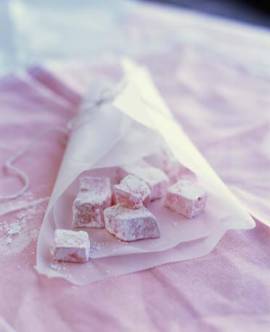
Turkish Delight"A Holiday Delight"Servings: Makes approximately 80 pieces Comments: A NOTE FOR THIS 2006 HOLIDAY SEASON, A well-known baker, chef, cookbook author, etc. is recommending some wonderful "perfumes" and other "beauty" items for this holiday season and I thought to myself, "sweets are the loveliest perfumes of all", so here is a recipe for Turkish Delight, which is "perfumed" with the most wonderful and natural scent of "rosewater". Enjoy the fragrance this holiday season and all through the coming year! About Turkish Delight Turkish towns are lined with sweet stalls selling unbelievable arrays of these aromatic treats and a relaxing hour spent acquiring each flavor is a traveller's essential. A British man must have been doing just that when he labeled them Turkish Delight, but their true name is Rahat Lokum, which means 'little bite of contentment'. These blissful sweets are usually served on birthdays or other special occasions and because they last for up to six months, most Turkish households have them on hand. Allow their soft texture and exotic taste to bring a sigh to someone's lips. Place the pretty bites in a box amid dustings of confectioners' sugar and finish with an organza ribbon for a truly lovely and different gift for the holidays. This appealing candy is easy to make at home. Rosewater can be found at specialty food stores* (See note below on Where to Buy Rose Water online). When the sugar syrup boils, coat the inside of the saucepan with a brush dipped in water to prevent sugar crystals from forming. Ingredients: 4 cups granulated sugar 4 1/2 cups water 2 teaspoons lemon juice 1 1/4 cups cornstarch 1 teaspoon cream of tartar 1 1/2 tablespoons Rosewater* (see note) Red or yellow food coloring (optional) 1 cup confectioners' sugar Instructions: Oil a 9-inch square pan. Line with plastic wrap and oil the plastic wrap. In a heavy saucepan over medium heat, combine the sugar, 1 1/2 cups of the water, and the lemon juice. Stir until the sugar dissolves and the mixture boils. Reduce the heat and simmer gently, without stirring, until the mixture reaches the soft-ball stage (240 degrees F/115 degrees C at sea level, or 28 degrees F/-2.2 degrees C above the boiling point of water as measured on your candy thermometer). Remove the pan from the heat. In a second large heavy saucepan over medium heat, stir together 1 cup cornstarch and the cream of tartar. Gradually stir in the remaining 3 cups of water until no lumps remain. Stir constantly, until the mixture boils and is a thick, gluey paste. Slowly pour the hot sugar, water, and lemon juice syrup into the cornstarch mixture, stirring constantly. Reduce the heat and simmer, stirring often to prevent sticking, for about 1 hour, or until the mixture has become a pale golden color. Stir in the rosewater and tint as desired with food coloring. Pour the mixture into the prepared pan and spread evenly. Cool to room temperature and let stand, uncovered, overnight to set. Sift the confectioners' sugar and the remaining 1/4 cup cornstarch onto a large cutting board. Turn the Turkish Delight out and cut into 1-inch squares with an oiled knife. Roll pieces in the sugar mixture to coat well. Store in an airtight container with sheets of waxed paper, dusted with the sugar mixture, separating every layer. *Note Rosewater can be purchased at some upscale gourmet food or cooking stores, at middle-eatern markets and online at: Amazon.com, kingarthurflour.com, gourmetsleuth.com, fancyflours.com, farawayfoods.com and at many other stores online. Makes approximately 80 pieces. Click here to view recipe and photo of Turkish Delight on Diana's Desserts Website 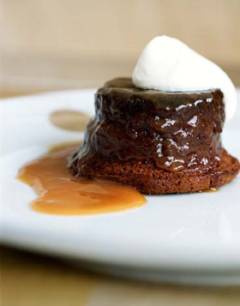
Sticky Toffee Date PuddingServings: 12Comments: Sticky Toffee Pudding - A Christmas Time Favorite in England and becoming a favorite elsewhere. A Little History of Sticky Toffee Pudding: Originally called "icky sticky toffee sponge", sticky toffee pudding is a British dessert composed of a moist sponge cake made with fine chopped dates and then covered with a toffee sauce. The dessert's origins are considered a "mystery" according the gastronomic journal, Saveur; however the dominant story is that Francis Coulson developed and served this dessert at his Sharrow Bay Country House Hotel in the Lake District in 1960. It has been stated by Coulson's former protege and chef, Juan Martin, that Coulson hinted that the original concept for the dessert was derived from a farm wife in Lancashire. However it was also found that the Landlady of The Gait Inn, Millington invented it in 1907 and was then sold in the pub much to everyone's delight. In any case, Coulson introduced and refined the dessert to the general public making his recipe completely accessible to all those who asked. A final story regarding the origins of the dessert involves The Udny Arms Hotel in Newburgh, Aberdeenshire. The hotel has claimed that it invented the pudding for years, and it is true that, if you ask almost anyone from the surrounding area, they will cite the hotel as the birthplace of the dish. Source: Wikipedia.com Which ever story is true, you definitely must try this wonderful moist and sweet pudding (they call cakes puddings in Britain). We would call these little goodies, cakes in the United States......Diana, Diana's Desserts Ingredients: Pudding: 1 cup whole dates 1 tsp. vanilla extract 1 tsp. baking soda 5 tbsp. butter, softened 2 cups all-purpose flour 1 teaspoon baking powder 1/4 teaspoon salt 3/4 cup granulated sugar 1 egg, beaten Toffee Sauce: 7 tbsp. unsalted butter 3/4 cup heavy cream 1 1/3 cups dark brown sugar 3 tbsp. water 2 tbsp. rum, or to taste (optional) Serve with: (optional) Whipped cream, vanilla ice cream or store-bought chocolate sauce Instructions: Bring a large pot of water to a boil. Add the dates, and boil for 5 minutes. Strain, and place the dates in a bowl of cold water. Working in the water, remove the skins and pits from the dates. Place the dates in a medium saucepan with 1 cup water, vanilla extract, and baking soda. Bring to a boil and allow to simmer for 2 minutes (watch carefully, as it will foam). Set aside to cool. Preheat oven to 350 degrees F/180 degrees C. Butter an 8 x 12-inch baking dish or 12 (6-ounce) ramekins very well. Combine the flour, baking powder, salt, and sugar in a bowl. Cream the butter briefly in a mixing bowl. Add the date mixture, dry ingredients, and beaten egg, and stir gently to combine. (Do not overmix.) Spoon the mixture into the prepared baking dish or ramekins until a bit less than half full. Set on a cookie sheet, and bake for 25 to 30 minutes. Toffee Sauce: While the pudding bakes, combine the butter, cream, and brown sugar with the 3 tablespoons water in a saucepan and bring to a boil. Reduce the heat and simmer for a few minutes, add rum (if using), and set aside, keeping the sauce warm. Remove the pudding from the oven when a skewer inserted in the center comes out clean. If using a large baking dish, cut the pudding into 12 squares. Pour the sauce over the pudding, allowing it to seep down around the sides and cover the top of pudding. (Use a fork to pull the pudding away from the pan, to get the sauce down the sides.) Bake for 2 to 3 more minutes. If making puddings in ramekins, spoon sauce over the tops of puddings in ramekins and bake 2 to 3 more minutes. Remove and cool to room temperature. Serve with whipped cream, vanilla ice cream or top with chocolate sauce instead of toffee sauce, if desired. Makes 12 servings. Click here to view recipe and photo of Sticky Toffee Date Pudding on Diana's Desserts Website 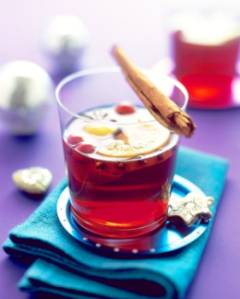
A Touch of Scandinavia for ChristmasDanish Christmas GloggServings: 18-20 (1/2 cup) servingsComments: Since I lived in Denmark for a short time and my husband Kenny and I were married there, we have many fond memories of this wonderful country and many wonderful friends who live there, so it's only fitting that I add this recipe for their traditional Christmas drink, Glogg. What is Glogg? Especially popular during Advent (the Christian time of preparing for Christmas), this Danish (or Swedish) spiced-wine punch gets its punch from the addition of aquavit or brandy. To take the chill off cold winter nights, it's served hot in cups with several almonds and raisins added to each serving. Ingredients: 2 quarts dry red wine 2 quarts muscatel 1 pint sweet vermouth 2 tablespoons Angostura Bitters 2 cups raisins 1 orange peel (without white part) 12 whole cardamoms, bruised in mortar & pestle 10 whole cloves 1 piece (about 2-inches in size) fresh ginger 1 stick cinnamon 12 ounces Aquavit 1 1/2 cups granulated or superfine sugar 2 cups whole blanched peeled almonds Garnish: Cinnamon stick Orange slices Instructions: Mix all the ingredients up to and including the 1 stick of cinnamon in a 6 to 8-quart enamel pot. Let stand, tightly covered, at room temperature for at least 12 hours. Shortly before serving, add Aquavit and sugar. Mix well. Heat rapidly to full boil. Remove from heat as soon as mixture boils. Add almonds. Serve hot, in small cups. Garnish with cinnamon sticks and orange slices. Makes approximately 18-20 (1/2 cup) servings. Source: Brown, D. Foods of the World: The Cooking of Scandinavia, Time-Life Books, New York, 1968. Click here to view recipe and photo of Danish Christmas Glogg on Diana's Desserts Website 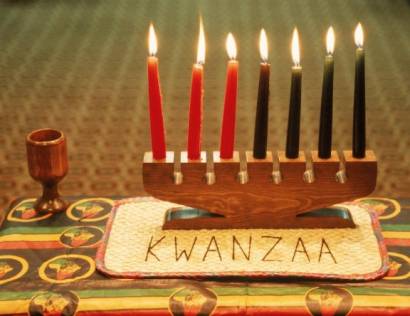
KwanzaaCelebrated from Tuesday December 26, 2006 to Monday January 1, 2007Though it is celebrated by millions of people annually, there continues to be curiosity about exactly what it is. Kwanzaa is a relatively new addition to the holiday calendar, and as holidays go, it's not religious, political, or heroic. It is a celebration of culture, community, and family. The holiday was created more than 30 years ago by Dr. Maulana (Ron) Karenga of California State University. The goal in creating the holiday was to recognize the culture of African-Americans and create a link with African peoples and tradition. Celebrated for seven days, December 26 through January 1, Kwanzaa is based on seven principles. Each day one of the principles is the focus of the holiday activity. The daily ritual begins with the lighting of one of the seven Kwanzaa candles by a family member or friend and a discussion of the principle the candle represents. 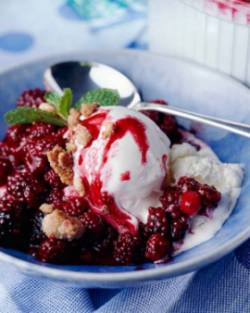
Blackberry SlumpServings: 6Comments: This recipe for Blackberry Slump comes from "Kwanzaa: An African-American Celebration of Culture and Cooking," by Eric V. Copage Cook's Notes: A slump is a cousin of the baked cobbler, only simmered on top of the stove. It must be served hot from the skillet, preferably with a big scoop of the best vanilla ice cream you can find. Ingredients: Blackberry Stew: 5 cups fresh or frozen blackberries 2/3 cup granulated sugar 2/3 cup water 1 tsp. vanilla extract Sweet Dumplings: 1 3/4 cups all-purpose flour 2 tablespoons granulated sugar 2 1/2 teaspoons baking powder 3/4 teaspoon salt 1/3 cup (a little over half a stick/4.8 oz./68g) unsalted butter, chilled, cut into 1/2-inch pieces 1/2 cup plus 3 tablespoons milk 1 pint vanilla ice cream, preferably homemade Instructions: Make the Blackberry Stew: In a 10-inch skillet, bring the blackberries, sugar, and water to a boil over medium heat, stirring occasionally to help dissolve the sugar. Reduce the heat to low and simmer until slightly thickened, about 5 minutes. Stir in the vanilla extract. Meanwhile, make the sweet dumplings: Sift the flour, sugar, baking powder, and salt into a medium bowl. Using a pastry blender or two knives, cut the butter into the flour mixture until it resembles course meal. Stir in the milk just until a soft dough forms. Drop the dough by heaping tablespoons into the simmering stew, making 12 dumplings. Simmer, uncovered, for 10 minutes. Then cover, and simmer until the dumplings are cooked through, 10 to 12 minutes. Divide the slump evenly among six dessert bowls. Top each with a scoop of vanilla ice cream, and serve immediately. Makes 6 servings. Click here to view recipe and photo of Blackberry Slump on Diana's Desserts Website 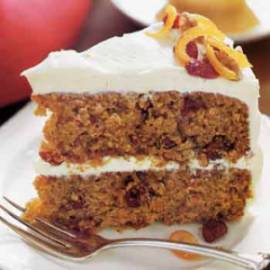
Sweet Potato Layer Cake with Orange Cream FrostingServings: 10-12Comments: Sweet potatoes make this cake moist and the cranberries and walnuts add texture and color. A lovely cake to serve for your Kwanzaa celebration. Ingredients: For the Cake: 2 pounds tan-skinned sweet potatoes (about 3 medium) 3 cups cake flour 2 teaspoons baking soda 2 teaspoons baking powder 2 teaspoons ground cinnamon 1 teaspoon ground ginger 1/2 teaspoon salt 1/4 teaspoon ground cloves 1 cup vegetable oil 1 cup granulated sugar 1 cup (packed) golden brown sugar 4 large eggs 2/3 cup chopped walnuts, toasted 2/3 cup dried cranberries For the Frosting: 1 (8-ounce) package cream cheese, room temperature 1/2 cup (1 stick/4 oz/113g) unsalted butter, room temperature 31/4 cups confectioners' sugar, sifted 2 tablespoons frozen orange juice concentrate, thawed 1/2 teaspoon vanilla extract For the Topping: 1/4 cup sliced candied orange peel 3 tablespoons granulated sugar 1/4 cup chopped walnuts 1/4 cup dried cranberries Instructions: For the Cake: Preheat oven to 400 degrees F/200 degrees C. Pierce potatoes with fork; place on small baking sheet. Roast potatoes until soft, about 1 hour. Cool, peel, and mash potatoes. Measure 2 cups mashed potatoes; cool to lukewarm (reserve any remaining potatoes for another use). Reduce oven temperature to 350 degrees F/180 degrees C. Butter and flour two 9-inch-diameter cake pans with 2-inch-high sides; line pans with parchment. Sift flour and next 6 ingredients into medium bowl. Combine oil, 1 cup sugar, and brown sugar in large bowl; whisk until smooth. Whisk in eggs 1 at a time, then mashed sweet potatoes. Whisk in flour mixture in 3 additions. Stir in the 2/3 cup walnuts and the 2/3 cup cranberries. Divide batter between prepared pans. Bake cakes until tester inserted into center comes out clean, about 30 minutes. Cool cakes completely in pans on racks. For the Frosting: Using electric mixer, beat cream cheese and butter in large bowl until fluffy. Beat in powdered sugar, scraping down bowl often. Beat in orange juice concentrate and vanilla. Cut around pan sides; turn out cakes. Peel off parchment. Place 1 cake layer, flat side up, on platter. Spread 3/4 cup frosting over. Top with second cake layer, flat side down. Spread remaining frosting over top and sides of cake. Combine orange peel, 3 tablespoons sugar, the 1/4 cup walnuts, and the 1/4 cup cranberries in a small bowl. Stir to coat with sugar. Transfer to sieve; sift off excess sugar. Sprinkle fruit and nut mixture decoratively atop cake. Chill until frosting sets, at least 2 hours. (Can be made 1 day ahead. Cover with cake dome; keep chilled. Let stand at room temperature 1 hour before serving.) Makes 10 to 12 servings. Source: Bon Appetit, November 2001 Click here to view recipe and photo of Sweet Potato Layer Cake with Orange Cream Frosting on Diana's Desserts Website 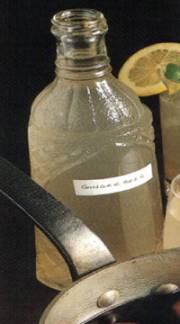
Ginger Beer
Servings: Makes approximately 1 gallon |

